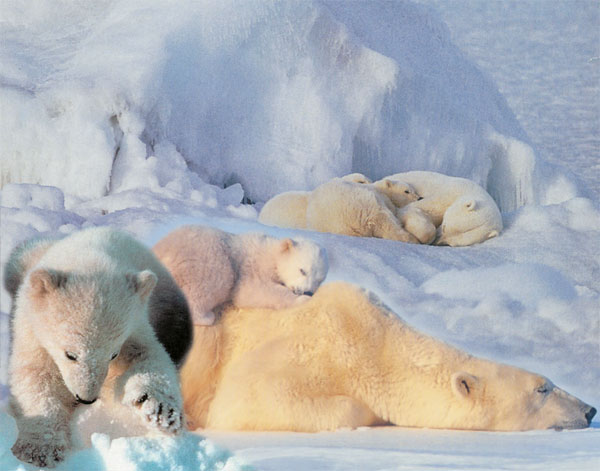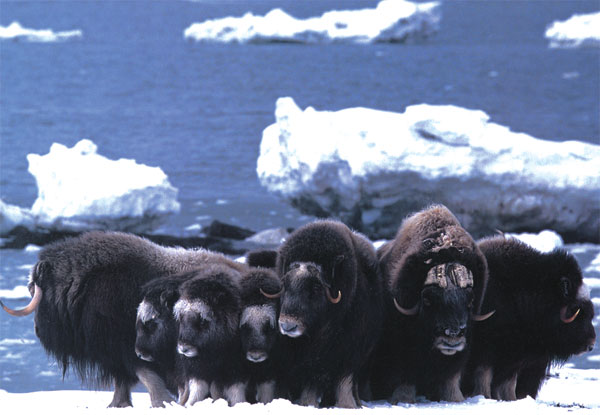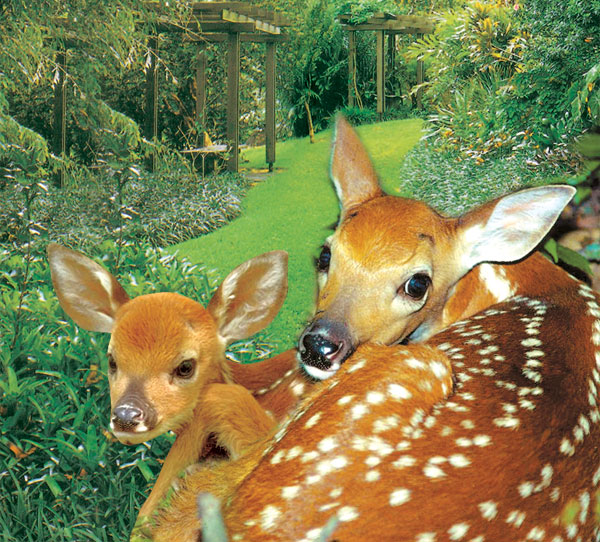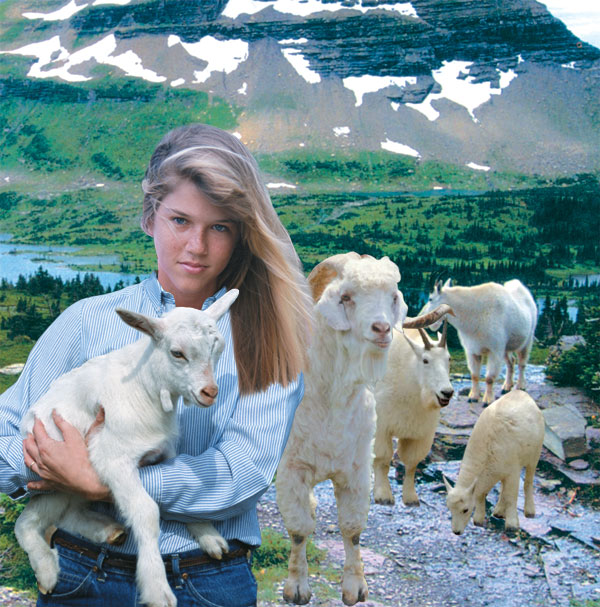In the middle of winter when brown bears are hibernating, their cubs are born blind and naked, without fur. They are the size of a chipmunk and have only enough strength to climb to the teats where they can find their milk. The female's milk is rich in calories and fat, and during the winter the cubs grow quickly. When their mother awakens up in the spring, the cubs are strong enough to follow her out of the den.
The cubs are very active and once outside, quite vulnerable. For a year they stay with their mother, who protects them from every danger while they learn how to look after themselves. Because they are fed constantly for a certain length of time, they grow quickly. Always playing games, they try to climb on top of their mother and wrestle with each other. Like other animal parents, mother bears can be very ferocious towards intruders who may want to harm their cubs. For three years, the mother bear looks after and protects her cubs constantly.14 (http://www.nationalgeographic.com/kids/creature_feature/0010/brownbears2.html)
 |
All That inhabits the night and the day belongs to Him. He is the All-Hearing, |
In the regions where seals live, spring temperatures seldom reach -5˚ C (23˚ F). But seals do not mind the cold, because their fur and stored body fat keeps them warm. Seals live in large herds, so how can a mother seal recognize her own cub in such a crowded environment? As do many other animals, she smells and fondles her baby after giving birth. Coming to recognize its scent, she never confuses it with other babies.
Baby seals are completely helpless and unable to protect themselves, but their mothers supply their every need. They are born covered with a layer of baby fat that insulates their tiny bodies and helps keep them always warm. The young of very few mammals grow as rapidly as baby seals do. Within three weeks, their weight increases three or four times! This is because seals' milk is twelve times fattier than cows' milk, with four times as much protein. This lets the babies grow very fast, and much of their mother's fatty milk is immediately transformed into a protective layer of fat in their bodies.15 (David Attenborough, The Trials of Life, pp. 36-38; Fort Wayne Children's Zoo, ZAP, "Bringing Up Baby;" http://www.kidszoo.com/pdfs/Br UpBaby.pdf)
Allah has created every creature in the best way, supplying its daily food and looking after all its needs:
How many creatures do not carry their provision with them! Allah provides for them and He will for you. He is the All-Hearing, the All-Knowing. (Surat al-'Ankabut: 60)
 |
Do you not know that Allah is He to Whom the kingdom of the heavens and the Earth belongs and that, besides Allah, you have no protector and no helper? |
Beneath the skin of polar bears, a layer of fat 11 centimeters (4.3 inches) thick serves as insulation. This lets them swim continuously for 100 kilometers (62 miles) in icy water at a speed of 10 kmph (6.2 mph). Polar bears are also equipped with a very acute sense of smell; able to smell carrion—a dead whale, for example—from as far as 32 kilometers (20 miles) away, and can sniff out seal dens covered with snow.16 ("Polar Bears," SeaWorld/Busch Gardens Animal Information Database, http://www.seaworld.org/infobo oks/PolarBears/pbadaptations.ht ml; Stirling, 1988; "Polar Bear," www.wonderclub.com/Wildlife/ mammals/PolarBear.htm)
Polar bear babies are usually born in the middle of winter, very small, furless and blind. They need a den to live in order to survive the subzero winter cold. But female polar bears make dens only when they are pregnant or have babies. Under banks of snow, they make their dens—round spaces about half a meter (1.6 feet) in diameter which they enter through a tunnel two meters long (6.5 feet).
Usually polar bears make more than one room in their dens, and typically place them at a level higher than the den's entrance. In this way, the warm air in the rooms, which naturally rises, is prevented from escaping through the entrance—because at the entrance to their dens, the bears always leave a channel open wide enough for air to pass through it.17 A mother polar bear constructs the roof of her shelter to be from 75 centimeters (2.5 feet) to 2 meters(6.6 feet) thick. Because of this special construction design, heat is retained.18 (International Wildlife, November-December 94, p. 15.)
 |
Everything in the heavens and Earth belongs to Him, and the religion belongs to Him, firmly and for ever. So why do you fear anyone other than Allah? |
A researcher once put a heat-sensing device in the roof of a den, with some very interesting results. When the temperature outside fell to as much as -30˚ C (-22˚ F), the air in the den never went below 2 or 3˚ C (36-37˚ F). Of course, it's impossible that a polar bear could plan such a den on its own, much less ensure that it maintained the proper temperature. It is Allah, with His limitless knowledge and eternal power, Who teaches polar bears to do these things. In the Qur'an, He tells us about His sovereignty over living creatures:
Everyone in the heavens and Earth belongs to Him. All are submissive to Him. (Surat ar-Rum: 26)
Shortly after mother penguins lay their eggs, winter comes. The females leave their nests to the male penguins and go back to the sea in search of food. In order to keep her egg from freezing, the father penguin carries it on the tops of his feet. His thick feathers will protect the egg from the cold.
This is a very difficult period for male penguins, since they must remain in the exact same place and cannot forage for food.
Tiny baby penguins are born in the spring. They have not yet developed the layer of fat that will protect them from the cold, so they remain on the top of their fathers' feet. Their first food is the gruel that their fathers have stored in their craw. Although the father penguin has not eaten in three months, he performs a great act of self-sacrifice by not swallowing the food stored in his craw, but keeps it for his offspring.
At exactly this time, the mother penguins return from the sea. They have not been idle for those three months, but have been hunting continually and bring back a store of food in their craws for their babies after they hatch. And as soon as they return andfeed their young, they return to the sea again—this time, to hunt for the fathers who have been without nourishment for four months now.19 (David Attenborough, The life of Birds, pp. 290-291.)
 |
Allah says, “Do not take two Gods. He is only One God. So dread Me alone.” |
Why a penguin would remain without food for four months and endure the cold for four months for the sake of its young? Proponents of the theory of evolution cannot explain it. Who inspires all penguins to perform such great acts of self-sacrifice? Who makes the males shelter their young on their feet for four months? To these questions, there is only one answer: Allah has created penguins. He has taught them all to perform these extraordinary acts of self-sacrifice in order to perpetuate their species.
The females of the musk ox, which lives in Alaska, northern Canada and Greenland, give birth to their young in May. Within one hour after its birth, baby musk oxen can stand up and follow their mothers around.
When they encounter an enemy, musk oxen face the aggressor, form a circle and push the young inside it. Each adult musk ox weighs between 350 and 400 kilograms (772 and 882 pounds), and by standing shoulder to shoulder, they form a veritable shield between their babies and any enemy. Every individual making up the circle will attack the enemy and return again to the circle so that it is not broken and the young remain protected. Evolutionists, who claim that nature is rife with cruelty and aggression, cannot explain this self-sacrificial behavior of musk oxen. There is only one explanation for this self-sacrifice: Allah, the Lord of all, in His supreme power has inspired in every creature these acts of self-sacrifice and extraordinary ways of protecting its young.20 (Russell Freedman, How Animals Defend Their Young, p. 75. )
 |
Do they not see that Allah, Who created the heavens and Earth, has the power to create the like of them, and has appointed fixed terms for them of which there is no doubt? But the wrongdoers still spurn anything but disbelief. |
All mammal babies spend a period of time in their mother's womb, and when they come into the world, not all are fully developed. A newborn kangaroo is no bigger than a bean, and its legs have only just begun to develop. When first born, baby kangaroos are blind. For this reason, the mother kangaroo's furry pouch is a very important place of security for the babies. This pouch expands as the baby grows and there are special muscles at its entrance that prevents the babies from falling out. When the mother goes into the water, these muscles prevent it from entering the pouch.21 (Creation, vol. 20, no. 3, June- August 1998, p.29; Kathy & Tara Darling, Kangaroos on Location, Lothrop, Lee & Shepard Books, New York: 1993. )
The kangaroo's milk is exactly what her baby needs. Over time, as the baby grows, the proportion of fat and other nutrients in the composition of the milk changes.
When the first baby is born and begins to nurse a second baby kangaroo is born immediately afterwards, and it too receives precisely the kind of milk that it can digest most easily. Then when her third baby is born, the mother begins producing three different kinds of milk, each with different nutrients! Each baby can easily locate the milk especially prepared for it; there is no confusion. Clearly this feeding system is the result of a special creation. No mother kangaroo could possibly organize this system consciously.22 (David Attenborough, The Trials of Life, pp. 30-33. )
How is it that these three different kinds of milk are delivered through three different ducts? How can an animal unknowingly calculate the compositions of the milk needed by its three different-sized babies? Even if it could, how could it produce it in its own body?
 |
And in your creation and all the creatures He has spread about there are Signs for people with certainty. |
Certainly, no kangaroo can perform any of this on its own; she does not even realize that her body produces three different kinds of milk. This extraordinary production is due to the wonder in Allah's creation of the kangaroos:
… No female becomes pregnant or gives birth except with His knowledge. And no living thing lives long or has its life cut short without that being in a Book. That is easy for Allah. (Surah Fatir: 11)
When baby raccoons are six months old, they leave their tree nests with their mother in search of food. Following the instructions their mothers give them, gradually they become skilled at hunting. Inspired by Allah, mother raccoons always look after their babies and protect them. Like all other animals, raccoons are under Allah's protection.
Even though baby deer can stand up right after they are born, they are essentially helpless and cannot walk until later. So meanwhile, how are they protected from their enemies?
Until it can run as fast as its mother, a baby deer's best protection is to hide. Because of the dead-leaf color of its fur and the spotted designs it is virtually invisible in its underbrush environment. The mother deer hides its baby in the forest where the white spots on the baby's reddish brown fur blend with dappled sunlight. When its mother is away foraging, the baby lies down and waits, motionless. Usually the mother deer is always somewhere nearby but, to avoid drawing attention to her baby, she rarely approaches it closely except for short visits.23 (Russell Freedman, How Animals Defend Their Young, pp. 47-48. )
 |
What is in the heavens and in the Earth belongs to Allah. Allah suffices as a guardian. |
How does the baby deer know that it must hide to protect itself? How does it know that the spots of its fur will blend with the overhanging vegetation and that enemies will not perceive it if it stays completely still?
Surely, the baby cannot know these things by itself. These features and behavior are inspired in it by Almighty Allah, Who knows all creatures' needs and protects them:
Everything in the heavens and everything in the Earth belongs to Him. He is the Most High, the Magnificent. (Surat ash-Shura: 4)
Shortly after birth, baby mountain goats must move on and follow their mothers, or they will remain unprotected. Allah has created every creature with perfection and has given it all the special characteristics it may require.
When baby mountain goats are born, they can hear and see. Their hair has already grown long enough to protect them against the cold, and they start to climb steep slopes with their mothers soon after they are born.24 (National Geographic Society, How Animals Care for Their Babies, s.8)
 |
And He created livestock. |
14. Catherine D. Hughes, "Brown Bears,"http://www.nationalgeogra pic.com/kids/creature_feature/00 10/brownbears2.html
15. David Attenborough, The Trials of Life, pp. 36-38; Fort Wayne Children's Zoo, ZAP, "Bringing Up Baby;" http://www.kidszoo.com/pdfs/Br UpBaby.pdf
16. "Polar Bears," SeaWorld/Busch Gardens Animal Information Database, http://www.seaworld.org/infobo oks/PolarBears/pbadaptations.ht ml; Stirling, 1988; "Polar Bear," www.wonderclub.com/Wildlife/ mammals/PolarBear.htm
17. Thor Larsen, "Polar Bear: Lonely Nomad of the North," National Geographic, April 1971, p. 574.
18. International Wildlife, November-December 94, p. 15.
19. David Attenborough, The life of Birds, pp. 290-291.
20. Russell Freedman, How Animals Defend Their Young, p. 75.
21. Creation, vol. 20, no. 3, June- August 1998, p.29; Kathy & Tara Darling, Kangaroos on Location, Lothrop, Lee & Shepard Books, New York: 1993.
22. David Attenborough, The Trials of Life, pp. 30-33.
23. Russell Freedman, How Animals Defend Their Young, pp. 47-48.
24. Roger B. Hirschland, How Animals Care for Their Babies, National Geographic Society, Washington D.C.: 1987, p. 8.